
| ||
Click here and here to hear what they say about me. In 2014 = 60 + 1954, with an Italian high-school girl in Florence (Italy).
| 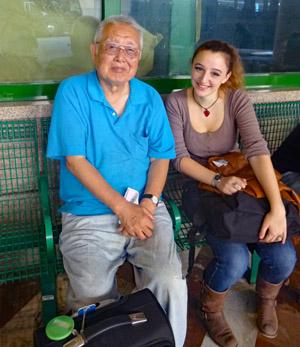
| |
High-School Diary of
Kim Young Suh
- Professor Emeritus
Department of Physics
University of Maryland
College Park, Maryland 20742, U.S.A.
Home page. -
In this photo of 1954 (my graduation year), I am shaking hands with
General Maxwell Taylor who was the commander of the U.S. Forces in Korea.
Under him were more than 300,000 combat-ready American troops.
General Taylor was a scholarly man and was keenly interested in Korea's educational system. He wanted to visit the best high school in Korea. He asked his Korean secretary which school to visit. The Korean secretary told Taylor about the high school he attended. He is also in this photo (far left).
- Taylor served as the Chairman of the Joint Chiefs of Staff during
the Kennedy admiration, and made a plan to invade Cuba during the
Cuban missile crises in October of 1962, resulting in the downfall of
Nikita Khruschev of the Soviet Union from his position as the
head of the Soviet Union.
- So many years after my high school graduation, I still talk like
a high school boy whenever I meet the girls. In Korea, according to the
Confucian tradition, high schools are single-gender schools. Thus, girls
used to appear to me like toys. They still do.
 Click here to enlarge this image.
Click here to enlarge this image.
- Toward the end of this webpage, I talk about how I constructed
Princeton's Einstein-Wigner-Kim
Genealogy (Jokbo), and how I used my high-school background during this
process.
Click here to see where I used what I learned during my high-school years.
Contribution of a New Culture: Alumni Contribution System!
- When I went to Princeton in July of 1958, I noticed many of the
buildings had personal names, such as Palmer Hall, Fine Hall, McCosh Hall,
1942 Hall, etc. Each building carries the name of the person or the
group of people who contributed money to construct it. They were the
graduates of Princeton University. The 1942 building was donated by
those who graduated in 1942.
It was one year after Principal Kim Won-Kyu left our school in 1957, and the morale of our students was sinking. In order to lift up their morale, I decided to send $100 per year to our high school. This became the beginning of our alumni contribution system. It went through several stages of evolutions, but I am most proud of giving, not the money but, the Culture of Alumni Contribution to my younger brothers. This culture is flourishing these days. If you made enough money, donate some to your school. This is the duty as a responsible alumnus. I become very happy whenever I hear the news like this:

- In Korea (1958), it was a very strange idea for high school or college graduates to
make monetary contributions to their alma mater. Thus, I became well known to Koreans
for this strange practice. Some people praised me, but most of them accused me of buying
fame with money. Things are different these days. Korea make a progress along this
direction.
 Click here to enlarge this image.
Click here to enlarge this image.
|
Korean War (1950-1953)
- The most serious event during this period was the Korean
War which lasted from 1950 to 1953. From July 1950 to
August 1951, there were no classes. In September of 1951,
out-door classes were held in Busan. We then moved to a
temporary campus early in 1952. We had classes there until
we returned to Seoul in September of 1953 after the
Panmunjom Cease Fire agreement was signed in July of 1953.
- The Korean War started when the NK army crossed the 38th parallel
on Sunday, June 25, 1950. The school classes were held on Monday,
June26, and we all thought the unification of the country was
imminent. We all expected that our (South Korean) army armed with
US-made M-1 rifles would march into Pyongyang in a week.
However, things turned out to be different. We were all sent back from the school on June 27. Click here for my stories of the Korean war (1950-53).
- There are a number of the war stories which I am the only person
who can tell. I will tell just one of them. After spending a
sleepless night of June 28-29 at the ground of Suwon railway station,
I was on a roofless cargo train car waiting for departure to Daejon.
Suddenly, a four-engined American plane was flying toward the Suwon Airport. We then heard machine-gun noises, and we saw fighter planes messing around. I later found out the big four-engined plane was MacArthur's plane called "Bataan," and General Mac was coming from Tokyo to inspect the war front in Korea. A North Korean Yak fighter was attempting to shoot down MacArthur's plane, but American fighters chased it away. I saw them with my own eyes and later collected the photos of those three planes, as shown here.
 Click here to enlarge this image.
Click here to enlarge this image.
- In September of 1951, our school managed to start school operation
on a mountain slope in Busan, and classes were held in open ground. We
then managed to move to a space available at flat place near the sea in
Busan. We built temporary classrooms there, and we studied there until
August of 1953.
On July 27 of 1953, the Panmunjom Cease Fire Agreement was signed. We all returned to Seoul, and started classes at our original campus. However, the main school buildings were occupied by the British troops who came to Korea as a unit of the United Nations Forces. We thus had to study in the auxiliary spaces on the campus. Yet, I was very happy to be back to our original campus.
- The following photos show the morning meetings at the Busan campus
and Seoul campus.
 Click here to enlarge this image.
Click here to enlarge this image.
- He often mentioned Eton and Harrow. What are they?
Click here.
Undergraduate Years (1954-1958)
- In September of 1954, I came to the United States to become a
freshman at the Carnegie Institute of Technology (now called Carnegie
Mellon University) in Pittsburgh, Pennsylvania.
The life was not easy for me, but I worked hard enough to get excellent grades.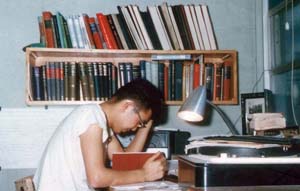 Click here to expand this photo.
Click here to expand this photo.
- On March 12, 1958, I received a letter from Princeton University
telling me I was one of fifteen students admitted to the graduate
program in physics. This was the happiest day in my life. Going
to Princeton meant working with Albert Einstein, even though he
died in 1955, three years before 1958.
- Click here for my photos form
Pittsburgh.
Princeton Years (1958-1962)
- In this photo of 1961, I am
making preparations for my paper to be published in the Physical
Review, the standard journal of the American physical Society.
- Thanks to my solid high-school background, I got excellent grades
during my undergraduate years. Again, thanks to the high-school background.
I completed my PhD degree in three years, but I was asked to stay
there for one additional year as a post-doctoral fellow.
My PhD thesis was based on the research topic popular among the physicists at that time, having nothing to do with fundamental problems in physics. Yet, I had to publish a number of nonsense papers to get the job and to get promoted.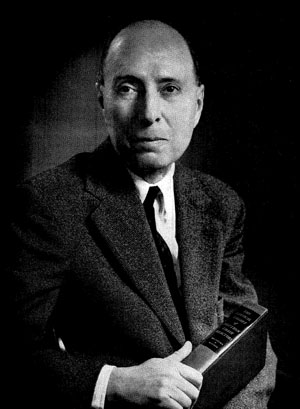
-
Eugene Paul Wigner (1902-1995), photo from from the Reviews of Modern Physics (1962).
- While that was going on, I started studying an important paper published by
Professor Eugene Paul Wigner
in 1939. This paper provides the mathematical framework for internal
space-time symmetries in Einstein's relativistic world.
However, it was impossible to understand its contents, because its description of massless particles was not complete. For this reason, Wigner was completely isolated from the rest of Princeton.
- Yet, I felt that there is a deep truth in his 1939 paper. I continued
studying this paper, and I was fortunate enough to ask Professor Wigner some
questions about his paper while I was at Princeton until 1962.
- Click here for my photos from Princeton.
- New York City is one-hour train ride from Princeton. I went there often while
I was at Princeton. I still like New York.
Click here for my photos from New York.
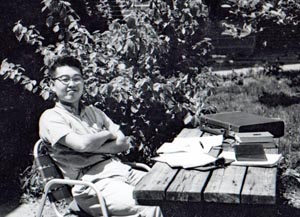
|
Period of Adjustments (1962-1966)
- In July of 1962, I became an assistant professor of physics at
the University of Maryland, near Washington, DC. This is a photo of
the physics faculty taken in the spring of 1963, and I am the youngest
person in this photo.
- The life was not easy for me in the highly
competitive academic world, where everybody is afraid of his/her
colleague becoming more famous than himself/herself.
- This is a human nature which can be described as
Herod Complex. Among my colleagues, there were several people who got
turned down from Princeton and went to other good graduate schools. Those
people were extremely nasty to me. However, I always got help from appropriate
persons whenever I was in difficulties.
- The University of Marland is only three hours of train ride from Princeton,
and I continued following Princeton's leadership in my research. However, In 1965,
I found out I should not trust Princeton's leadership in physics.
Click here for why. The only Princeton persons I could
trust were Albert Einstein and Eugene Wigner.
- For most Americans, including those in the academic world, the ultimate value is money. However, I was not brought up in this way in Korea. For Koreans, the family background still plays the important role. The genealogy is above the money. My ultimate aim in physics has been and still is to place my name in Einstein's genealogy.
- This is a human nature which can be described as
Herod Complex. Among my colleagues, there were several people who got
turned down from Princeton and went to other good graduate schools. Those
people were extremely nasty to me. However, I always got help from appropriate
persons whenever I was in difficulties.
- Thus, my research line has been very strange to my American colleagues.
Yet, the University of Maryland provided me enough freedom to do what I really
wanted to do.
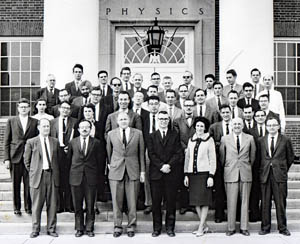 Click here to expand this photo.
Click here to expand this photo.
|
Greater Washington Area (since 1962)
- The most rewarding aspect of my life at the University of Maryland
is that the campus is near the city of Washington, DC.
 Click here to expand this photo.
Click here to expand this photo.
- When I came to this area in 1962, Washington was a sleepy southern town.
Washington is now an international city. It was an exciting experience to
witness its transformation process.
I could meet many interesting people from different parts of the world. I had a photo with these two young ladies from Argentina at a riverside restaurant. The Kennedy Center for Performing Arts is seen in the background.
- Click here for photos
from this interesting city.
 Click here to expand this photo.
Click here to expand this photo.
- There is a large Korean community in the Washington area with many
Korean restaurants and meeting places. Koreans hold many interesting
meetings and festivals. I enjoy them.
Many Korean politicians come to Washington to get supports from their American counterparts. We laugh at them, but the truth is that Washington is an important place for Korea as a democratic nation.
- Some people say Washington is the capital city of South Korea. If
this is the case, I hope Washington will become the capital city of
North Korea soon, and it is said that Kim Il-Sung's great grandson
lives in the Washington area. This seems to be the easiest way for
two Koreas to become one country again.
Click here for Koreans in Washington.
Construction of the
Princeton Genealogy of
Einstein-Wigner-Kim
- Even though I was away from Princeton, I used to think the ultimate
wisdom in physics comes from Princeton. However, in 1965, I realized that
Princeton is not necessarily the holy place in physics.
Click here for my explanation.
After this incident, I decided to develop my own research line. When I was at Princeton, Eugene Wigner (1902-95) was No. 2 man there, only after Albert Einstein. Wigner received his Nobel prize in 1963, but not for 1939 paper, providing the mathematical framework for internal space-time symmetries for particles with space-time extensions, such as the hydrogen atom and the proton in the quark model.
- In order to find my own way, I continued studying this paper.
My friends told me I was wasting time for worrying about this worthless paper,
because Wigner did not get the Nobel prize for this paper. Indeed, it was
a great opportunity for me to transform into a historical document.
- The Massive particle has three internal degrees of freedom. They correspond
to the spin of the particle. The massless particle has only two degrees
of freedom, namely its helicity and the unobservable gauge transformation.
Wigner's 1939 paper explains the massive particle, but not the massless
particle.
- Einstein's energy-momentum relation for massive particles becomes that
of massless particles when in the high-speed/small-mass limit. Does Wigner's
three spin degrees of freedom for the massive particle become the helically
and gauge degrees of freedom in the high-speed/small-mass limit, as in the
case of Einstein's energy-momentum relation?
- One hundred years ago, Bohr was interested in the hydrogen atom, leading to the present form of quantum mechanics. Einstein was interested in how things look to moving observers. Then, how would Bohr's hydrogen atom appear to moving observers?
We have to answer these three questions to make Wigner's 1939 paper a historical document. It was not an easy task, but I am proud to tell you that I carried out this task.
- The Massive particle has three internal degrees of freedom. They correspond
to the spin of the particle. The massless particle has only two degrees
of freedom, namely its helicity and the unobservable gauge transformation.
Wigner's 1939 paper explains the massive particle, but not the massless
particle.
- I published enough papers with my younger colleagues, namely
D. Han and S. Son, on the issues
1 and 2.
Contents of Einstein's E = mc2
Particle Massive/Slow between Massless/Fast Einstein Energy
MomentumE = p2/2m E =
(m2 + p2)1/2E = cp Wigner Helicity
spin, GaugeS3
S1 S2Winner's
1939 paperHelicity Gauge Trans. This table is from from from the 1986 paper I published with my younger colleagues. I then went to Princeton, and showed this table to Professor Wigner. He became very happy, and agreed to publish papers with me. Indeed, we finalized the first two issues by publishing two papers: one in 1987 and the other in 1990. The issue is to extend Einstein's energy-momentum relation to the internal space-time symmetries.
- In approaching Wigner, I used a piece of Korean wisdom.
Let us look at the following pictures.
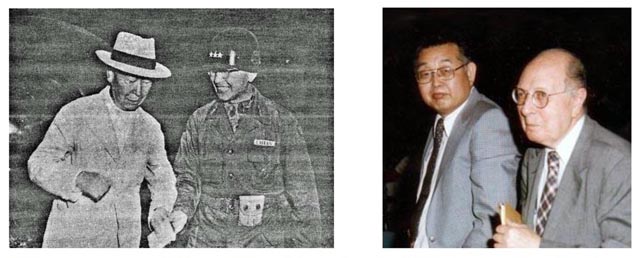
Chung Il-Kwon talking to President Rhee, and Kim with Wigner (1986). Rhee Seungman was Korea's first president. He always wanted to hear the stories he wanted to hear. Otherwise, you were out!
Chung Il-Kwon was a young officer in the Korean army. He had a talent of telling Rhee the stories he wanted to hear. As the army chief, Chung was the most influential man during the Korean War and during the after-war constructional process. I followed Chung's example when I approached Wigner. I told Wigner what he wanted to hear.
- Let us finally go to issue 3. The best way to illustrate Einstein's
relativity is to use the following figures.

Toyotomi Hideyosi is an important figure in Japanese history. He unified Japan by brutally eliminating his rival warlords. He built his Osaka Castle and lived there. He had many wives and concubines.
He is known as "Pungsin Soogil" in Korea. What he did to Korea and Koreans during the 7-year period (1592-98) are well known to all Koreans.
In Japan, he is known as "O-Saru San" (Mr. Monkey). Indeed, he is a monkey if humans look at him, but he is a human if monkeys look at him.
- Here comes Einstein. How would he look to observers on a moving train? If the human body is too complicated, let us choose the hydrogen atom.
During the early years of the 20th Century, Niels Bohr was worrying about the hydrogen atom, while Einstein was interested in how things look to moving observers. They met occasionally to discuss physics. If they talked about moving hydrogen atoms, there are no written record on this issue.
The question then is whether the Bohr-Einstein issue of the hydrogen can be interpreted in terms of the scientific language Wigner constructed in 1939. The answer is YES. Let us look at this figure:

Click here to expand this figure.This figure indicates most of the ground works were done by Paul A. M. Dirac, and I had an audience with him in 1962. I respect him and his writings are like poems. However, there are no figures in his books or papers. I translated his writings and formulas into pictures. Then, it is easy to integrate them.
- So far, we did mathematics. In physics, the most cruel test is to see whether this mathematical shows up in the real world. The answer is Yes. Click here for explanations.
In 1978, with my younger colleagues, I wrote a paper saying that Wigner's 1939 paper plays an essential role in studying moving quantum bound states, like the hydrogen atom or the proton in the quark model. I submitted this paper to the Journal of Mathematical Physic in late 1978, and it appeared in the Journal in early 1979. Here is the paper. This paper allows me to add the third row to the Einstein-Wigner table given above.
This table was published in my paper of 1989.Further Contents of Einstein's E = mc2
Massive/Slow between Massless/Fast Energy
MomentumE = p2/2m Einstein's
E=(m2 + p2)1/2E = cp Helicity
Spin, GaugeS3
S1 S2Wigner's
Little GroupHelicity
Gauge Trans.Hadrons,
Bound StatesGell-Mann's
Quark ModelWigner's
1939 paperFeynman's
Parton Picture
Click here for further contents of this table.
- Let us translate this table into the plain language:
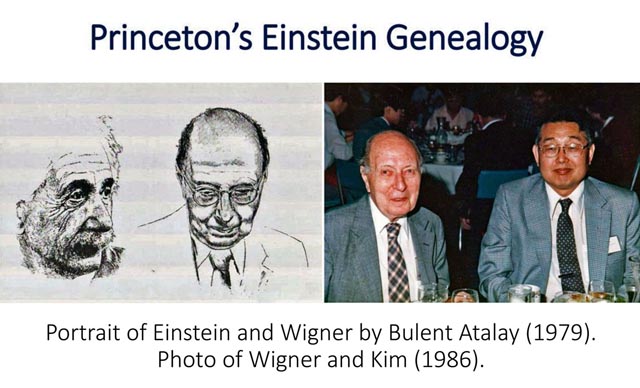
- OK. The genealogy is now complete. Click here for 100 years of the history of physics.
- Both Einstein and Wigner came from Europe. Their way of thinking was heavily influenced by two philosophical giants named Immanual Kant and Georg W. H. Hegel. As you know, American philosophy is money. Kant and Hegel are strange names on American campuses.
How about Korean philosophy? Even if you do not know anything about Kant or Hegel, you have to pretend to know about them in order to prove you are an educated person in Korea. I think I know something about them. Click here.
Indeed, the above figure consists of three Kant-Hegelianists. Click here to see how I talked to Einstein.
- Einstein is an important historical figure known to everybody in the world.
If I keep singing Einstein, the public media pay attention to me.
- This is the cover of
the magazine published by
IAOTP, International Association of Top Professionals.
Let us listen to what they say about me. This video says: One hundred years ago, Niels Bohr was worrying about the electron orbit of the hydrogen atom, leading to quantum mechanics. Albert Einstein was interested in how things look to moving observers. Then the question is how the hydrogen atom appears to moving observers. Bohr and Einstein met occasionally, but they never discussed this problem. This video says I am the one who settled this issue. Go back to the image given above.
- Toward the end, this video says I had a strong high-school background before coming to the United States from Korea in 1954.
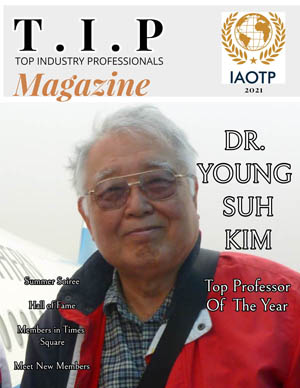
- This is the cover of
the magazine published by
IAOTP, International Association of Top Professionals.
- Marquis Who's Who is the most
prestigious company in the world for personal biographies. Let us see
what they say about me.
-
Let us hear what they say about me.
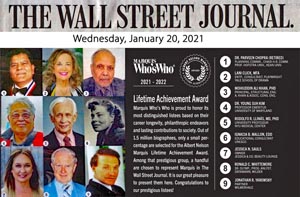
Click here to enlarge this figure. - Wall Street Journal 2021.
- Fortune Magazine 2021.
- Millenium Magazine 2021.
- Marquis Timeline.
- American Way.
- Hemisphere Magazin:
-
Let us hear what they say about me.
- Here is the list of my publications. You will
note that I have been talking about Einstein in recent years. The world
"Lorentz group means the mathematics Einstein used to formulate his theory
of relativity.
- copyright@2021 by Y. S. Kim, unless otherwise specified.
- How did I talk to Einstein?
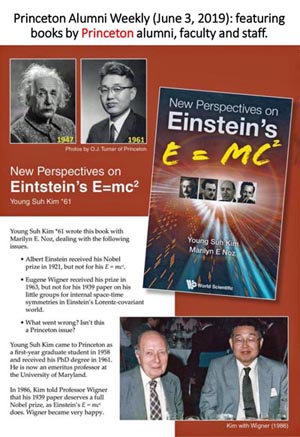
- Here comes Einstein. How would he look to observers on a moving train? If the human body is too complicated, let us choose the hydrogen atom.

